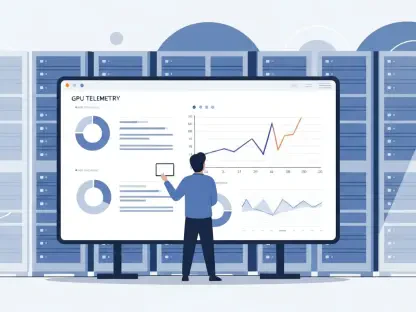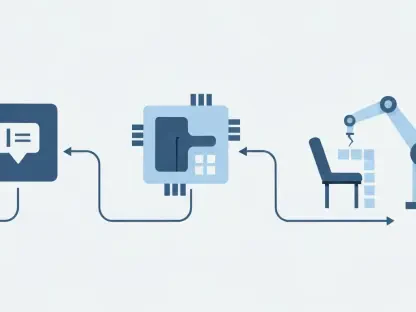Dive into the enigmatic realm of quantum computing, where groundbreaking technology collides with staggering financial speculation, and IonQ stands at the forefront with a jaw-dropping market valuation of $20 billion, a figure that looms large over Bank of America’s conservative estimate of a $4 billion total addressable market (TAM) for the industry by 2028. This vast discrepancy—five times the projected market size—sparks intense debate among investors and analysts alike about whether this valuation reflects genuine potential or mirrors the speculative frenzies of past tech bubbles like the dot-com crash. The implications are profound, as quantum computing promises to reshape fields from artificial intelligence (AI) to cryptocurrency, yet the financial risks of overvaluation could lead to sharp market corrections if hype overtakes reality. This exploration seeks to unpack the layers of excitement and caution surrounding IonQ, delving into its valuation challenges, cross-market impacts, and strategic considerations for navigating this high-stakes landscape.
Valuation Concerns and Market Reality
Examining the Valuation Disparity
The stark contrast between IonQ’s $20 billion market capitalization and the $4 billion TAM projected by Bank of America for quantum computing by 2028 paints a troubling picture of potential overvaluation. This 5x multiple suggests that investor enthusiasm may have surged far beyond the industry’s near-term commercial prospects. Quantum computing, while revolutionary in theory, remains in its infancy, with scalable, revenue-generating applications still on the horizon. Bank of America’s estimate reflects a cautious outlook, factoring in limited adoption and high development costs over the next few years. For IonQ to justify its valuation, it would need to capture an outsized share of a market that doesn’t yet fully exist, a feat that seems improbable without significant technological breakthroughs. This mismatch underscores a broader concern in emerging tech sectors where speculative capital often inflates valuations before tangible results emerge, leaving investors vulnerable to sudden shifts in sentiment.
Historical parallels to tech bubbles, such as the dot-com era of the late 1990s, offer a sobering lens through which to view IonQ’s current standing. During that period, companies with little to no revenue saw their stock prices soar on promises of future dominance, only to collapse when the market demanded proof of profitability. IonQ’s situation echoes this pattern, as its valuation appears driven more by optimism about quantum computing’s transformative potential than by concrete financial metrics. Unlike established tech giants with diversified income streams, IonQ operates in a niche, unproven field where delays in achieving milestones like quantum supremacy could trigger investor skepticism. The risk of a bubble bursting looms large if the company fails to deliver on its ambitious roadmap, potentially dragging down not just its own stock but also broader confidence in the quantum sector. This historical context serves as a reminder that while innovation fuels growth, unchecked speculation can lead to painful reckonings.
Skepticism Among Analysts
Analyst perspectives, particularly from institutions like Bank of America, lean toward caution when assessing the quantum computing landscape and IonQ’s place within it. The modest TAM projection of $4 billion highlights a belief that widespread commercial adoption remains years away, constrained by technical challenges and the high costs of quantum hardware development. Many experts argue that while the technology holds immense long-term promise, current valuations reflect a disconnect between market excitement and practical realities. This skepticism isn’t isolated to IonQ but extends across nascent tech fields where hype often outpaces fundamentals. For investors, this means tempering enthusiasm with rigorous due diligence, focusing on verifiable progress over speculative narratives. The consensus suggests that without near-term evidence of scalable applications, companies in this space risk facing sharp corrections as market patience wears thin.
Beyond individual company assessments, broader industry trends fuel this wariness among financial analysts monitoring quantum computing. The sector’s growth trajectory is often compared to early-stage technologies like AI in its infancy, where initial overinvestment led to periods of disillusionment before practical use cases emerged. For IonQ, the challenge lies in bridging the gap between laboratory achievements and market-ready solutions within a timeframe that sustains investor confidence. Analysts also point to competitive pressures, as other players in the quantum space vie for dominance with alternative approaches like superconducting qubits. This competitive uncertainty adds another layer of risk to an already speculative valuation, prompting calls for diversified investment strategies that look beyond a single stock or sector. The overarching message from the analyst community is clear: while the potential is undeniable, grounding expectations in realistic timelines is essential to avoid the pitfalls of past tech manias.
Cross-Market Implications
Quantum Computing’s Influence on AI and Crypto
Quantum computing’s potential to revolutionize artificial intelligence stands as one of its most compelling promises, with implications that ripple into the cryptocurrency market through AI-focused tokens. By dramatically accelerating complex computations, quantum systems could enhance machine learning algorithms, unlocking new capabilities in data processing and predictive modeling. This synergy fuels interest in crypto projects tied to AI innovation, such as those developing decentralized networks for computational power. As IonQ and similar companies advance their quantum technologies, parallel movements in the value of AI-related tokens could emerge, driven by shared investor optimism. However, this interconnectedness also means that any setbacks in quantum progress might dampen sentiment across these markets, creating a cascading effect. The excitement is palpable, but the lack of immediate, tangible results in quantum-AI integration keeps this relationship speculative at its core.
Another critical dimension of quantum computing’s impact lies in its threat to blockchain security, a cornerstone of major cryptocurrencies like Bitcoin and Ethereum. Current cryptographic standards underpinning these digital assets could be vulnerable to quantum algorithms capable of breaking encryption at unprecedented speeds. This looming risk has sparked concern among crypto investors, as the integrity of blockchain networks hangs in the balance. Simultaneously, it has catalyzed innovation in quantum-resistant cryptographic solutions, with projects like Quantum Resistant Ledger gaining traction as potential safeguards. For the broader crypto market, this dual dynamic of risk and opportunity creates a complex landscape where the advancement of quantum technology could destabilize established coins while fostering growth in niche, adaptive alternatives. Navigating this terrain requires close attention to both technological developments and market sentiment shifts.
Broader Market Ripples and Opportunities
The interplay between quantum computing and cryptocurrency markets extends beyond direct security concerns to influence broader investment trends. As quantum advancements potentially disrupt traditional tech sectors, institutional interest in related crypto assets—particularly those tied to AI or quantum-safe protocols—could intensify. This trend mirrors historical patterns where emerging technologies drive speculative waves across adjacent industries. For instance, whale accumulation in certain digital currencies during tech-driven rallies suggests growing confidence in cross-market narratives. However, the volatility tied to IonQ’s speculative valuation could also trigger correlated sell-offs in these assets if negative sentiment spreads. Investors must remain vigilant, balancing the allure of high-growth opportunities with the inherent risks of markets driven by unproven technologies.
Adjacent sectors, such as semiconductors that support quantum hardware, present alternative avenues for capital allocation with potentially lower speculative risk. These industries stand to benefit indirectly from quantum advancements, as demand for specialized chips and infrastructure grows. Moreover, improvements in semiconductor efficiency could enhance crypto mining operations, particularly for Bitcoin, offering a tangential but valuable connection to digital asset markets. Diversification into these areas provides a buffer against the volatility of stocks like IonQ, allowing investors to gain exposure to quantum computing’s upside without betting entirely on a single company or technology. This strategic approach underscores the importance of looking beyond headline-grabbing valuations to identify sustainable value within the broader tech ecosystem. Ultimately, the cross-market implications of quantum computing demand a nuanced perspective that weighs innovation against financial prudence.
Trading Strategies and Risk Management
Navigating Stock Volatility
IonQ’s stock price history, marked by swings between $10 and $40, presents a volatile yet potentially lucrative opportunity for traders attuned to market dynamics. Resistance levels near $25-$30 often signal overbought conditions, making these zones attractive for short-selling strategies aimed at capitalizing on potential pullbacks. Conversely, support around $15 during downturns could offer entry points for those anticipating a rebound, provided fundamental catalysts like technological milestones emerge. This price behavior reflects broader sentiment swings in the quantum computing sector, where news of progress or delays can trigger sharp movements. Traders must employ technical analysis tools to identify these critical levels while remaining cautious of sudden shifts driven by speculative fervor rather than concrete developments. Risk management, through stop-loss orders and position sizing, becomes paramount in such an unpredictable environment.
Beyond technical patterns, a deeper understanding of market sentiment and external factors influencing IonQ’s stock is essential for effective trading. Institutional flows, analyst upgrades or downgrades, and broader tech sector trends can significantly impact price action, often overshadowing the company’s intrinsic progress. For instance, negative sentiment in the tech equity space could drag down IonQ regardless of its individual achievements, amplifying downside risks. Traders should monitor macroeconomic indicators and industry-specific news, such as funding announcements or partnerships in quantum research, to gauge potential catalysts. Hedging strategies, like options contracts, can also mitigate exposure to unexpected corrections while allowing participation in upside potential. The key lies in balancing speculative trades with disciplined risk controls to navigate a stock that epitomizes the high-stakes nature of emerging tech investments.
Crypto Correlations and Strategic Plays
In the cryptocurrency realm, correlations between tech stock sentiment and AI-related token prices offer unique trading opportunities tied to quantum computing developments. As optimism or pessimism surrounding companies like IonQ fluctuates, parallel movements in tokens focused on AI innovation often follow, driven by shared investor narratives around technological progress. Traders can leverage tools like perpetual futures on major exchanges to capitalize on these shifts, particularly with pairs involving Ethereum or Bitcoin. Monitoring sentiment indicators and volume trends in both markets becomes critical to timing entries and exits effectively. However, the inherent volatility of crypto assets demands caution, as rapid price swings can amplify losses if not managed with strict risk parameters. Staying ahead of news cycles related to quantum advancements ensures traders are positioned to react to market-moving events.
Diversification across crypto assets and traditional equities forms another pillar of risk management in this interconnected landscape. While AI tokens may offer upside during quantum-driven rallies, exposure to quantum-resistant cryptocurrencies provides a hedge against potential disruptions to blockchain security. Simultaneously, allocating capital to less speculative sectors, such as semiconductors supporting quantum infrastructure, can stabilize portfolios against the wild fluctuations of tech stocks and digital currencies. Fundamental analysis remains a cornerstone, with an emphasis on tracking verifiable milestones in quantum computing—such as achieving quantum supremacy—that could validate market enthusiasm. For traders, the challenge lies in synthesizing cross-market data to build strategies that exploit correlations while safeguarding against the cascading risks of speculative bubbles. This multifaceted approach underscores the need for adaptability in a rapidly evolving financial frontier.
Reflecting on Speculative Risks
Looking back, the journey through IonQ’s towering $20 billion valuation against a modest $4 billion TAM revealed a landscape fraught with speculative excess and untapped potential. The cautionary parallels to past tech bubbles served as a stark reminder of how quickly hype could unravel without substantive results. Discussions around cross-market impacts illustrated the intricate ties between quantum computing, AI, and cryptocurrency, where innovation sparked both opportunity and vulnerability. Trading strategies, honed on volatility and correlation, offered a pragmatic lens for navigating this uncertainty. Moving forward, the focus should shift to actionable vigilance—prioritizing investments grounded in demonstrable progress, diversifying across sectors to mitigate risk, and closely tracking technological milestones that could redefine market realities. As the quantum computing narrative continues to evolve, balancing enthusiasm with disciplined analysis will be crucial for investors aiming to harness its promise without succumbing to its pitfalls.









